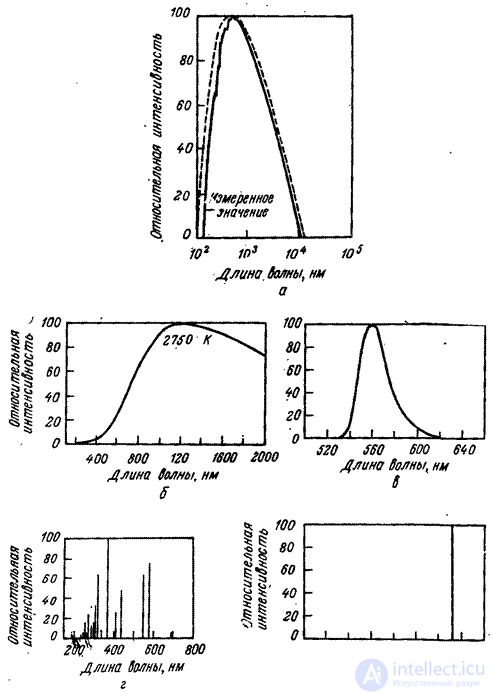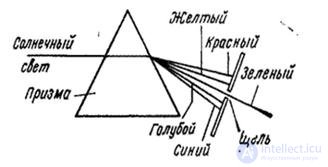Lecture
According to Webster's dictionary [1], light is "radiant energy, which, acting on the organs of vision, enables them to perform visual functions." The physical properties of light are studied quite well, but the mechanism of interaction of light with the organs of sight is not yet completely understood. As is known, light is a form of electromagnetic radiation lying in a relatively narrow region of the spectrum in the wavelength range from 350 to 780 nm. The characteristic of the light source is the radiation intensity of a given wavelength. Light enters the human visual system either from a self-luminous source, or reflected from a certain object, or transmitted through it. Let be  is the spectral density of the radiation of the primary light source, and
is the spectral density of the radiation of the primary light source, and  and
and  - transmittance and reflection coefficient, respectively. Then for an object that transmits light, the spectral density of the radiation of the observed light will be
- transmittance and reflection coefficient, respectively. Then for an object that transmits light, the spectral density of the radiation of the observed light will be
 , (2.1.1)
, (2.1.1)
but for a light reflecting object,
 . (2.1.2)
. (2.1.2)

Fig. 2.1.1. The spectral density of the radiation of conventional light sources [2]: a - sunlight; b - tungsten incandescent lamp; in - the light-emitting diode; g - mercury arc lamp; d - helium-neon laser.
In fig. 2.1.1 shows the graphs of the spectral radiation density of some conventional light sources used in imaging systems: solar, tungsten incandescent lamps, light-emitting diodes, mercury arc lamps and helium-neon laser. The light from these sources is perceived by the audience in different ways. Sunlight appears very bright and yellowish-white, and incandescent light less bright and rather yellow. The light emitting diode gives a dim green light, and the mercury lamp is very bright, bluish-white. Finally, the laser creates an extremely bright light beam of pure red. These observations give rise to many questions. For example, does the spectral density of radiation completely describe the perception of this radiation? As will be seen, only a partial answer to this question has been received.

Fig. 2.1.2. Refraction of light in a prism.
There are three main characteristics of the sensation of light - lightness, color tone and saturation. These characteristics are discussed below.
If there are two light sources with the same shape of the spectral density of the radiation, the source with a higher intensity of radiation is perceived as brighter. However, there are many examples where an object with the same intensity of radiation from all points is not perceived as having a uniform lightness. Consequently, the intensity of light is not an adequate quantitative measure of lightness.
A sign that differs, for example, red light from green, is called a color tone. With the help of the prism and slit shown in fig. 2.1.2, you can get almost monochromatic light of different colors. It is clear, however, that the wavelength is not an adequate measure of color, since in nature there are such colors that are not observed in the rainbow created by the prism. For example, there is no magenta color, which can be obtained by mixing equal quantities of narrow-band red and blue light. If two light sources with the same spectral densities are observed under the same conditions, their color tone will be the same. However, you can take two of these light sources with different spectral densities, which will be perceived as having the same color tone (such two radiations are called a metamerical pair.)
The third characteristic of the sensation of light is its saturation. This feature allows you to distinguish the spectral color from the pastel faded color of the same color tone. Essentially saturation describes the "whiteness" of a color. You can measure saturation in percent by comparing this light with the spectral color on the chromaticity graph shown in Fig. 3.4.3. However, usually saturation is not used as a quantitative characteristic.

Fig. 2.1.3. Subjective color characteristics.
To classify colors, it is convenient to consider them as points of a certain color space (Fig. 2.1.3). But in order to be able to make quantitative conclusions, the distance between two points in the color space must correspond to the subjectively perceived difference between the colors represented, wherever this pair of colors is. Such color spaces will be discussed below.
Comments
To leave a comment
Digital image processing
Terms: Digital image processing